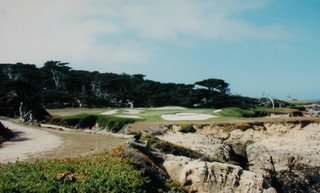Bunker Week – Part 7 – Visual

The movement and drama of Thompson
Bunkers are the most visual and memorable of all the elements found on a course. So much so that some including myself would argue that too much attention is spent on the aesthetics of the bunkers. This may be funny considering most feel that one of my greatest strengths is the quality of my bunkering. Almost all golfers and critiques revolve around the look and playing characteristics of the bunkers and often fail to notice the quality of all the other elements that make up a golf course. A great set of greens are far more important than great bunkers, but everyone is drawn to evaluating a course by the bunkers since they are far easier to judge and far more obvious to the eye. Since bunkers are so obsessed over, particularly the aesthetics, let’s take a look at that aspect.
Elegant simplicity of Travis
The one wonderful impact of bunkers is there are so many possibilities. We have the rugged look of Coore and Doak, sod walls of the links, the wild fingers and bays of Thompson, Tillinghast and MacKenzie, the rugged faces and depth of a Colt bunker, the engineered steep walled bunkers of Raynor and Banks, right through to the dull maintenance and player friendly bunkers of modern architecture. Again, there are ven more from the raw scars to sand blowouts to the inverted bunkers of Travis and Emmet; I really only touch the surface with this list too. So we have established that the actual options are limitless. So why do some projects like Pacific Dunes and Sand Hill work so much better that Atlantic or other modern projects. Or a better question may be, why do architects only make one type of bunker when we have all this limitless option to choose from (that answer is comfort). The answer is that most great bunkering has more to do with reflecting the nature of the site than it does with even with placement.
The movement and artistry of macKenzie
Alister MacKenzie said, “All the artificial features should have so natural an appearance that a stranger is unable to distinguish them from nature itself.” When adding a bunker to a site, you have two options, you can have it blend in which will always work, or you can have it offer a contrast which when done well is spectacular. When done poorly it is a disaster! The work of Raynor and Banks offers an example of contrast that works well by contrast. Why does there work fit? Because they tie everything back into original grade despite the severity of the hazard form. The remainder of the hazard is a s natural as can be. Where it gets more interesting is the chocolate drops of Travis and Leeds that still are spectacular despite their obvious complete contrast. That is a harder thing to explain other than to point out that each feature is hand-made and none look quite like any other. The reason modern features look lousy is they are repeated endlessly because a machine has that ability. Robert Hunter describes this well when he said “All artificial hazards should be made to fit the ground as if placed there by nature. To accomplish this is a great art. Indeed, when it is really done well it is, I think it may truly be said a fine art, worthy of the hand of a gifted sculptor.”
In my experience only a handful of architects have been able to create bunkers that blur the line between strategy and art. The greatest of all was Alister MacKenzie. He was able to comine artistry, with scale, a little intimidation, a tremendous amount of strategy and the greatest blending an architect has ever done. He to this very day remains the standard to what any architect must hold his bunker work, since he is the only architect to manage to have it all work perfectly.
The blowouts of Sand Hills
There is one alternative to all of this to achieve really great bunkering. Go out and find a natural one that you won’t have to create. After all Donald Ross pointed out to us, “The fascination of the most famous hazards in the world lies in the fact that they were not and could not have been constructed.”
Building a Bunker: http://thecaddyshack.blogspot.com/2006/10/bunker-week-part-7-building-travis.html

No comments:
Post a Comment